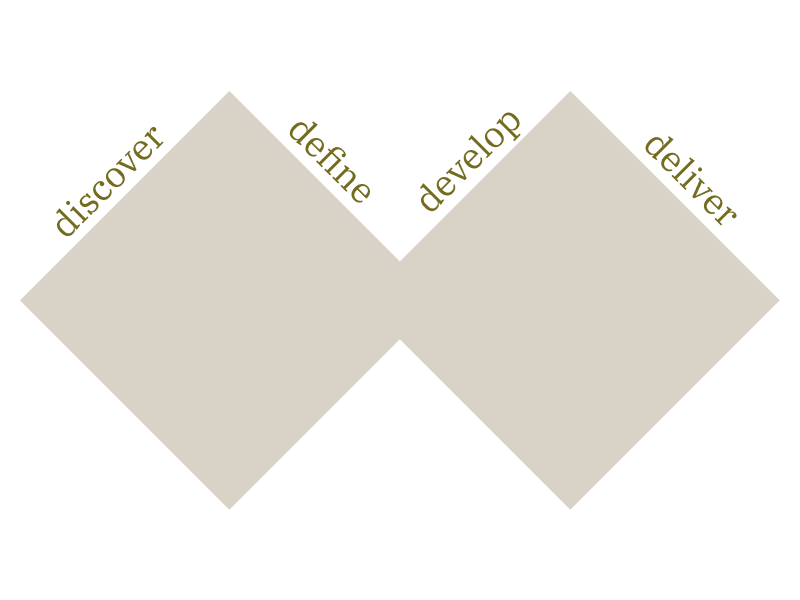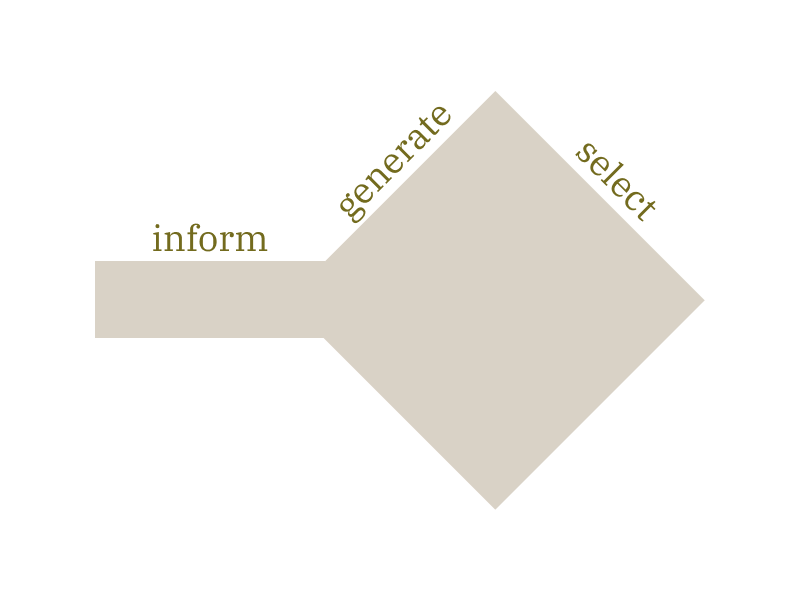Single diamond, the basic form of the creative process
If you search the web for "double diamond" you'll find a great many articles describing a design or product management or product development process in which you
- choose what to build
- discover – gather insight into the problem area(s)
- define – express the area to focus on as a distinct selected problem
- then build it well
- develop – generate potential solutions
- deliver – make and ship a potential solution
Some people call this "build the right thing" and "build the thing right." "Discover" and "develop" are meant to be generative, expansive processes, and "define" and "deliver" are meant to be specifying/selecting/contracting processes. This puts an expansion and a contraction in each of two phases, hence the diamond shapes. There are two phases, hence "double diamond."

One of the reasons that the double diamond fails to satisfy is that it expresses each activity as either an expansion, a generation of ideas, or a contraction, a selection among those ideas. Generation and selection are important, and the way a team needs to think while generating is different than while selecting, but there's much more to do than just generation and selection. The dirty little secrets of the double diamond are that it
- misses the relatively linear work of actually producing a solution, even as a test,
- expresses the informative first phase, the research inherent to "discover," as an expansion, which it might only accidentally contain,
- skips a step where you select among the available solutions in an informed way to get to where you can actually work on and ship one of them.
I happen to think of a UX process in three horizons or phases. (Already we are off the double diamond.) Each of these contains some learning and some making. The learning might inform us (not necessarily expansion) or it might help us select (contraction). The making might be generative (expansion) or it might be adding specificity (contraction). So in each phase there's some expansion and contraction going on, each pair making a single diamond.

(This three-phase approach actually maps somewhat closely to the Ideo Human Centered Design Process, consisting of inspiration, ideation, and implementation.)
If you search the web for "single diamond" you'll find a lot of gemstones. But this basic idea of informing/immersing, then generating, then selecting, maps quite nicely onto a general creative process that humans already naturally go through if they are adept at creating.
If you watch trained professional designers work, those that do not rely on inspiration or deadline panic, you see this process in action. They learn about the space in which they are working, they switch off the evaluator and cheaply/quickly make lots of diverse possibilities, many of them not very good, then they shift into evaluation mode and choose among the possibilities those that are worthy of improvement or delivery. A ton of that generated work is discarded, but the resulting item or items are much better for having gone through this process. Immersion, generation, selection. I've witnessed the process many times, but especially among industrial designers at Medtronic and Belkin, nearly all of whom were trained at Art Center, Long Beach State, or RISD.
If you watch adept untrained designers, the same thing typically happens. They take a number of rough stabs at the work before choosing a direction to go. They may already be immersed in the space in which they are working they generate, then they select. it took me a while to adopt this process, but my own work and the work of the people I support is much better for it.
A similar thing happens when jazz musicians improvise. First, they immerse themselves in the space in which they will be improvising by rehearsing the underlying tune and by playing scales in harmony with different passages of the piece. They then practice improvising within and around the harmonic structure of the piece for many hours, experimenting with sounds and passages. While practicing improvising the evaluative part of their thinking is muted, but as they continue they amass a vocabulary of musical fragments that they like, chosen from the many that they have created. And when it comes time to perform, they have the selected fragments at their fingertips. Immersion, generation, selection.
Meanwhile designers whose work isn't very good, or who are in a rush, or people taking a stab at designing who don't understand design, often make one or two crucial mistakes. Some tend to skip the inform/immerse art of the process, meaning that they'll come up with solutions that are poorly-informed, not well-suited to the problem at hand. Some try to generate and evaluate at the same time, and end up coming up with one maybe passable solution that's not nearly as good as they would have made had they generated for a while without evaluation.
(The second mistake is similar to what happens if you are brainstorming and someone is shooting down ideas during the meeting. The evaluation interferes with the generation, and little of value is actually created.)
Immersion, generation, selection. It's the basic form of the creative process.